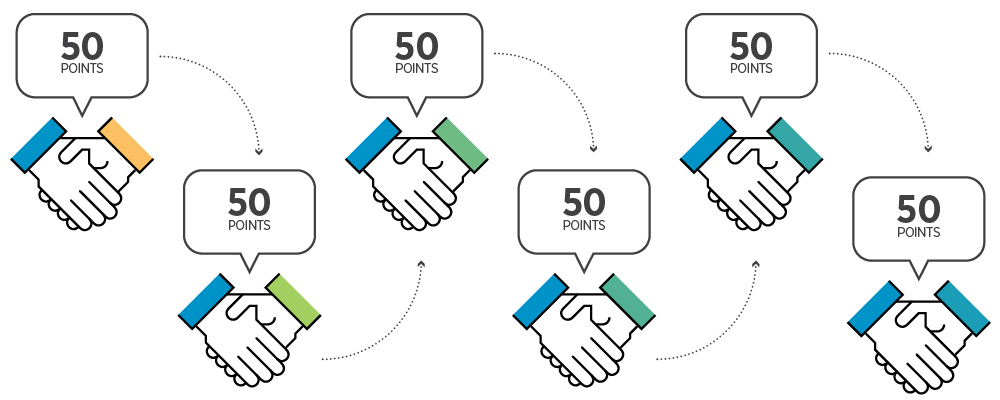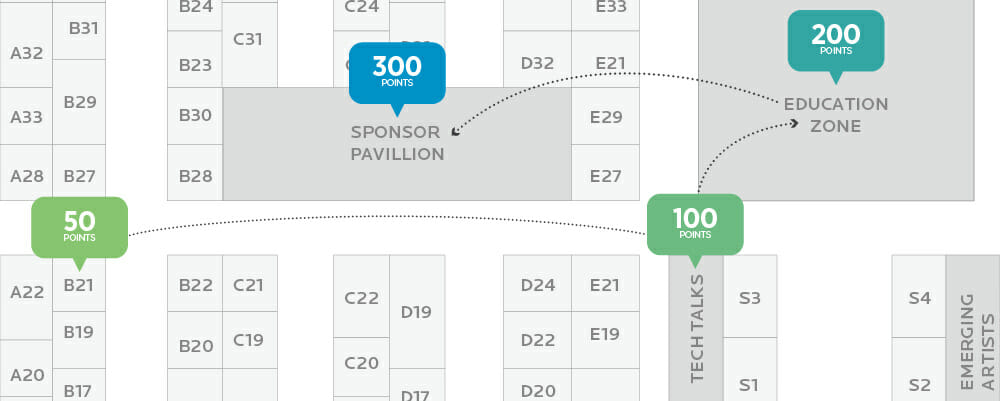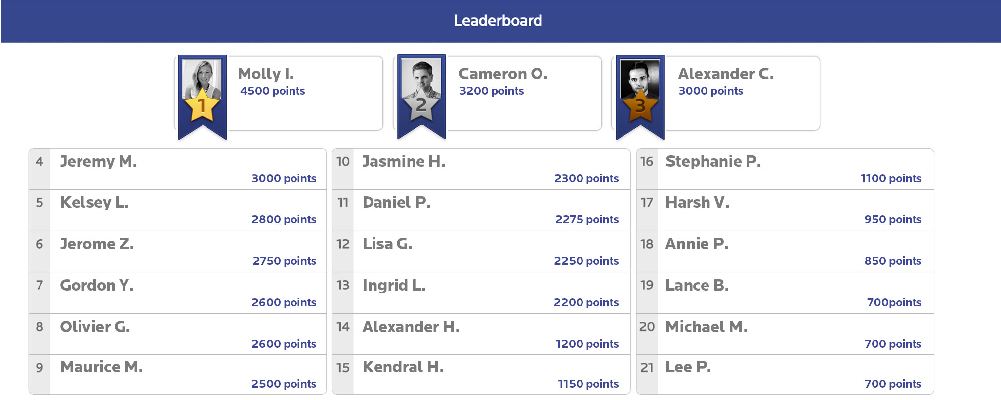Achieving Unparalleled Engagement Using Event Games
Businesses are always seeking new ways to engage with audiences, employees, and prospective markets, and recently there has been a significant study of gaming as a way to accomplish this. Event gamification is of interest for its unique ability to engross people, often for hours, and get them to invest significant amounts of time and energy.
Video games have become particularly adept at this, with avid players collectively logging billions of hours a week on games with a range of complexity. Gamification seeks to harness the mechanics that make these games so compelling and leverage that time and energy investment within a business context.
Event gamification is used to engage attendees, modify their behavior, and accomplish event goals. Games can make any aspect of an event more engaging by appealing to the same things that make games so addictive: a series of challenges to rise to, a sense of accomplishment, a mix of immediate and long-term gratification, and a little healthy competition.
Still, the challenge with any new technology is to make sure the usage is high enough to generate a positive ROI. Since the launch of EventMobi’s first event game in 2013, hundreds of planners have used event games to enhance their events. Celebrating the release of our latest version, we surveyed a group of the most successful planners to find out how they were able to get their attendees so excited to be involved. Their success can be attributed to a combination of intelligent game design and strategic marketing.
Design the Event Gamification Around Event Objectives
In-app event games are easy to design, deploy and play. The EventMobi team will work with you to determine the event gamification strategy, challenge types, and use-cases that best serve your event objectives. A balance of educational and social challenges create a cohesive and fun event experience.
Gamify Learning
Education is an important part of many meetings, and challenge cues placed strategically throughout sessions will keep people engaged. Reinforce the content by rewarding attention and retention with multiple-choice challenges.
The key is to make sure the speakers are well prepared. Each speaker should be familiar with the game’s mechanics and rules so they know exactly how to prompt the audience and what instructions to deliver. Speakers can preface key takeaways in their presentations by letting the audience know that the information might be important for a challenge, which could take the form of a quiz at the end of the session. Alternatively, speakers can punctuate the main points by integrating the challenges within his or her presentation, and the audience can pull out their phones and tablets to complete it on the spot. An audience that knows prized knowledge may come up at any moment is an alert audience on the edge of its seat.
Networking Challenges
Gamifying session content is great for adding a new dimension to engagement, but events exist to bring people together. Making connections at events can be daunting; turning it into a game is a great way to bring people out of their shells and reinvigorate them after a day of sessions. Typically, this works by giving each person a passcode that they reveal as an icebreaker when they want to speak to someone. The winner is normally the person who makes the most connections, but the incentives can be extended by rewarding the fastest networker, the most diverse networker, and having prizes for collecting passcodes from everyone in a particular team or group.
As for the passcodes, it’s your prerogative to assign one to everyone or let them choose their own during the registration process (more on this later!). For a twist on this basic format, plant “mystery minglers” in the crowd. Networking becomes a numbers game as each player speaks to anyone and everyone to discover the prized conversationalists. Another take on this version of the icebreaker for internal events is to assign varying point values for upper-level staff, encouraging staff to get to know people outside their normal circles.
Check-in Challenges
Games are also a great way to move people around your event. Check-in challenges allow attendees to score points through event gamification by entering a passcode provided at a given location, like an exhibitor or sponsor booth. This could incentivize them to visit certain companies on the exhibition floor. You can also assign varying point values to give your sponsors a bump, spreading them strategically around the exhibition floor to drive foot traffic and floor coverage.
Marketing Your Event Game
Once the game has been designed, the next step is to figure out how to get your attendees to play it. Promoting the game is essential to yielding high adoption and ensuring success, but as with any marketing effort, there’s a timeline to consider. Marketing early is always a good idea, and setting the right tone should start in the earliest communications. In your messaging, communicate that the event technology is integral to the event, and that participation in the game is part of the full experience.
Have Key Players Champion the Event App
Another way to generate an early buy-in is to do a slow roll-out, first promoting the game to influencers and visible stakeholders to champion the event app, then VIPs, and then everyone else. Getting buy-in from visible personalities at the event will help you set the right example and convey a powerful endorsement of the technology. This is particularly effective in internal or corporate events, where top-level support for the event technology is key to getting everyone onboard. EventMobi can help you promote the event app and game with custom-branded promo videos that highlight the event app’s core benefits and deliver effective instructions for accessing the app.
Take it a step further at your next event: pre-load all the profiles and photos for your influencers on the event app to set a precedent for everyone else to follow.
Event Gamification for Encouraging Early Registration to Save on WiFi
Hotels often offer several WiFi packages, and the unlimited package isn’t always in the budget. Use pre-event challenges to incentivize early registration, motivating participants to use their own internet instead of the venue’s to download the event app and game. This will also give you some indication of how many tech-users to expect so you can plan accordingly.
An early registration challenge might involve including a passcode that attendees can use to earn points on the confirmation page and confirmation email. Alternatively, prep people for a networking game by telling them to set up their profile on the event app ahead of time, and ask them to choose their own unique networking passcode. Using a fun and engaging challenge like this allows attendees to hit the ground running and accelerates the excitement with a fun first impression.
Keep Up the Momentum with Event Gamification
Getting everyone involved with pre-event challenges is great, but be sure to nurture this initial burst into steady engagement throughout the event. Get your keynote, MC, or C-level staff to reinforce the emphasis on the game by mentioning players and commenting on the gameplay. You don’t always need a prize. If you’re running a corporate sales meeting and your attendees are competitive sales reps, prestige and status are great rewards for a well-played game. Bring up the game in the opening ceremonies to underscore its role in the event experience, and set the expectation that anyone playing could be recognized at any moment.
Reward Loudly and Often
Players can get discouraged if they think the winning spot is too far out of reach, which can happen if there is only one winner and the top player is too many points ahead. They may also lose focus if the gameplay is really long and the winner is only announced at the end. This is because a major mechanism that drives gaming motivation is gratification, both immediate and long-term. Video games are particularly good at delivering positive feedback and other rewards at regular intervals, and that’s part of what makes them so addictive.
Using this power for good, display a live leaderboard for all to see and consistently recognize those at the top. Appeal to both short and long-term gratification by combining short and long-term challenges, highlighting winners of particular challenges, top competitors by day, and an overall winner at the end of the event.
Event games on the app are much easier to execute than analog alternatives. Everything is captured digitally and automatically so you can decide winners instantly, without having to manually check or tally answers. Third-party tracking, instant tie-breaking, and live leaderboard are just some of the advantages of EventMobi gamification.
Pay Attention to Pacing
Pacing in the event game is another major factor in keeping people interested. Staggering challenges throughout the event allows attendees fresh and novel opportunities to engage with the event game, and it makes frequent bursts of short-term gratification much easier. An array of pre-scheduled alerts and onsite prompts are available to keep everyone apprised of new challenges, and regular leaderboard highlights will help to keep up the friendly competitive spirit.
Frequency is one aspect of pacing, but varying the types and difficulty of challenges is also important. A full day of session challenges might make the game seem like more of an extended exam. Similarly, if all the challenges seem really difficult, there is risk of people becoming disinterested in the game or, conversely, preoccupied with it. Event gamification should underscore rather than overshadow the event. Alternate session and leisure challenges, and favour light and engaging challenges over difficult or repetitive ones when doing networking games. Vary challenge content to keep the event game novel and make sure everyone has a chance to score some points.
An easy challenge one planning team used to introduce everyone to the event app involved a tattoo booth where everyone could get a unique temporary tattoo and earn points for checking into the activity. In contrast, the “mystery mingler” challenge is a little more difficult but reinforces an important activity.
Analytics: The Proof is in the Pudding
The last piece of the puzzle is to track the attendees’ participation and engagement in order to assess ROI and plan for next year, all of which is managed through EventMobi analytics. Be sure to define the activities and metrics that mean success to your organization before the event begins. If the event game is meant to help people network, make sure you design challenges to be conducive to tracking that metric. For an icebreaker challenge, the number of completed challenges and the number of players will give you an average rate of engagement for each person. If you’re using an event game to move people around an exhibition trade show, you can track how many booths each player checked into. Being aware of what you want the game to accomplish will enable you to watch the relevant stats as the game goes on and modify as necessary.
Gamification leverages the same motivational psychology and incentives that have made games a worldwide phenomenon, and gets participants excited to achieve your event goals. To learn more about event gamification and how to use it to achieve the objectives at your next event, check out our implementation guides and eBook.




